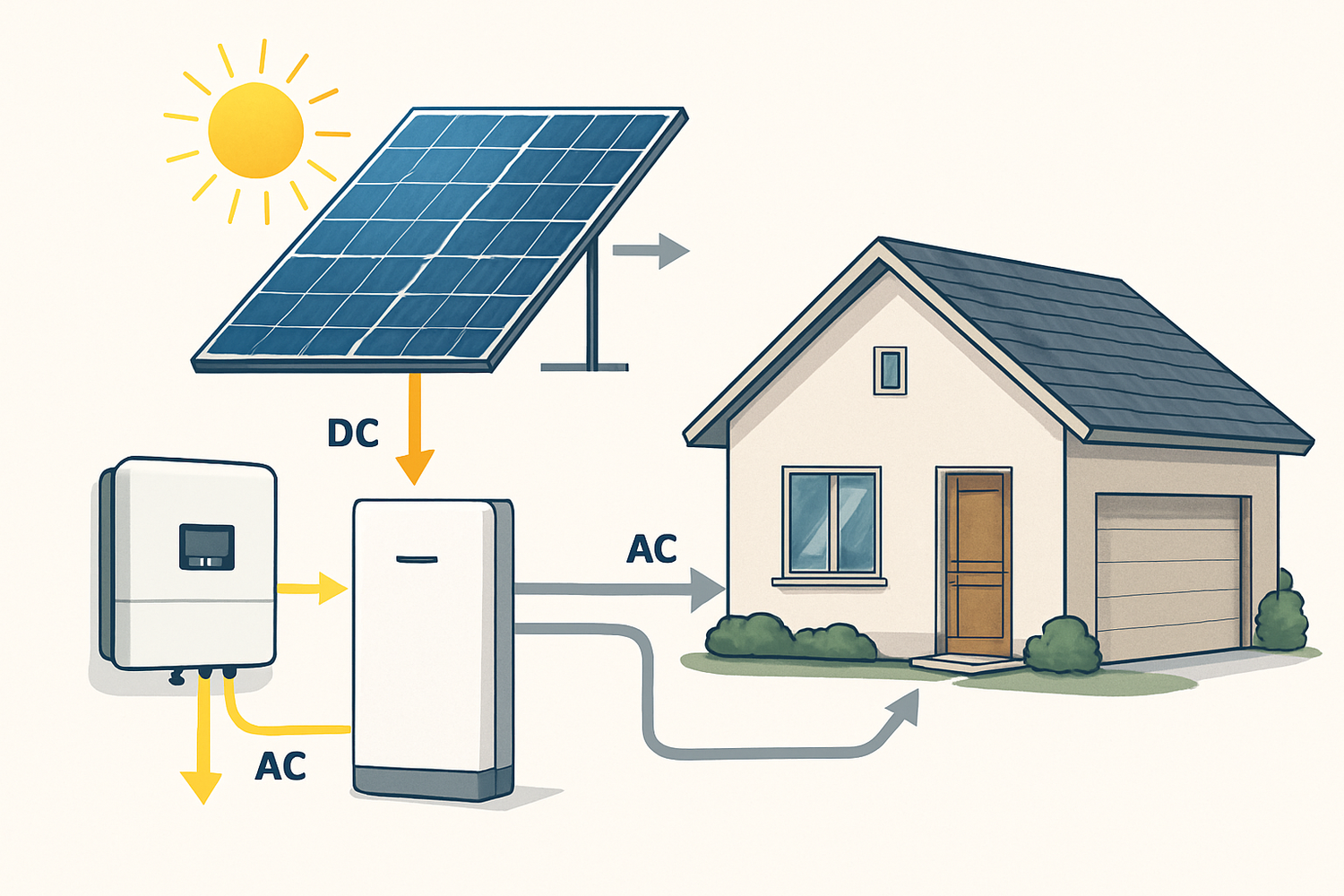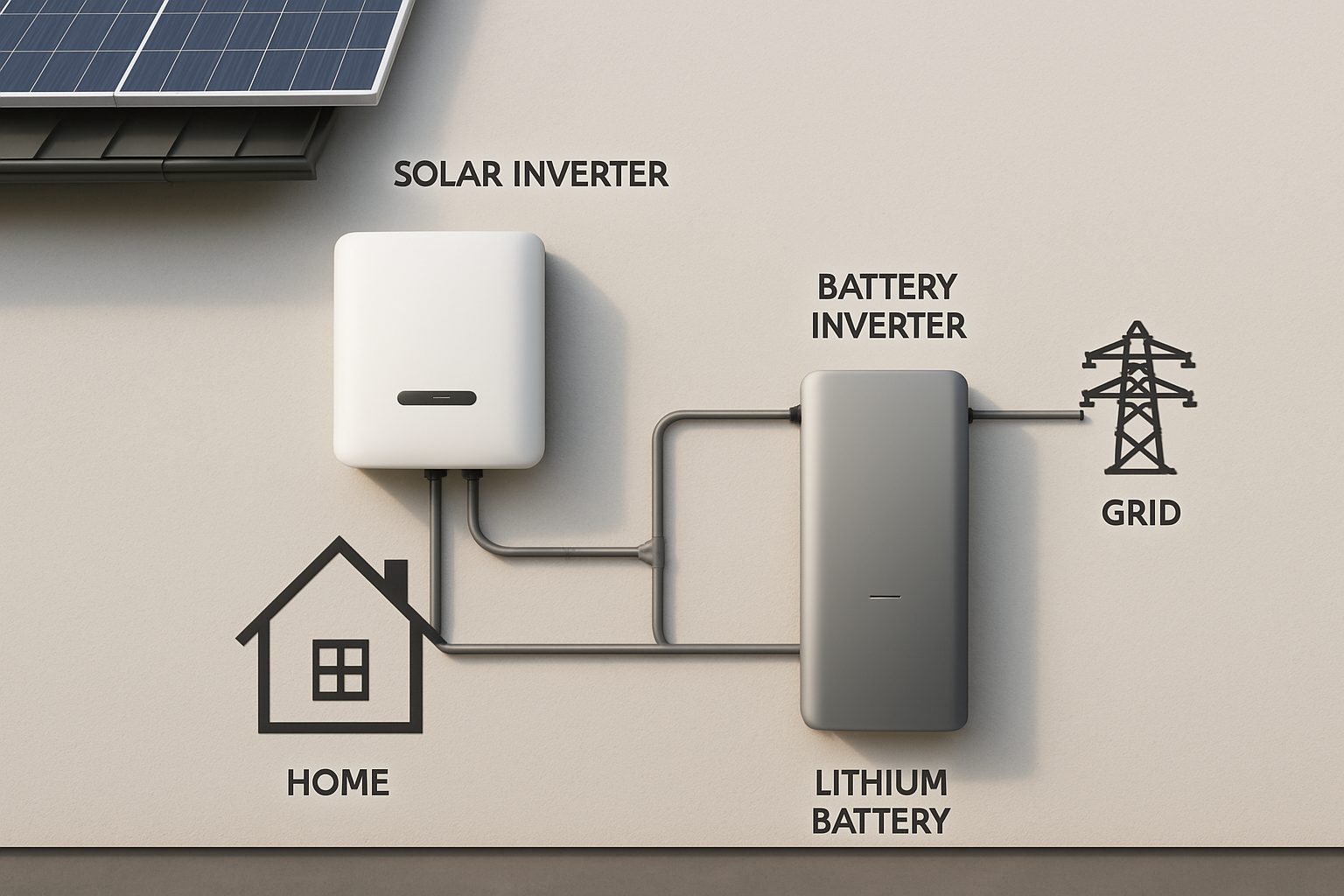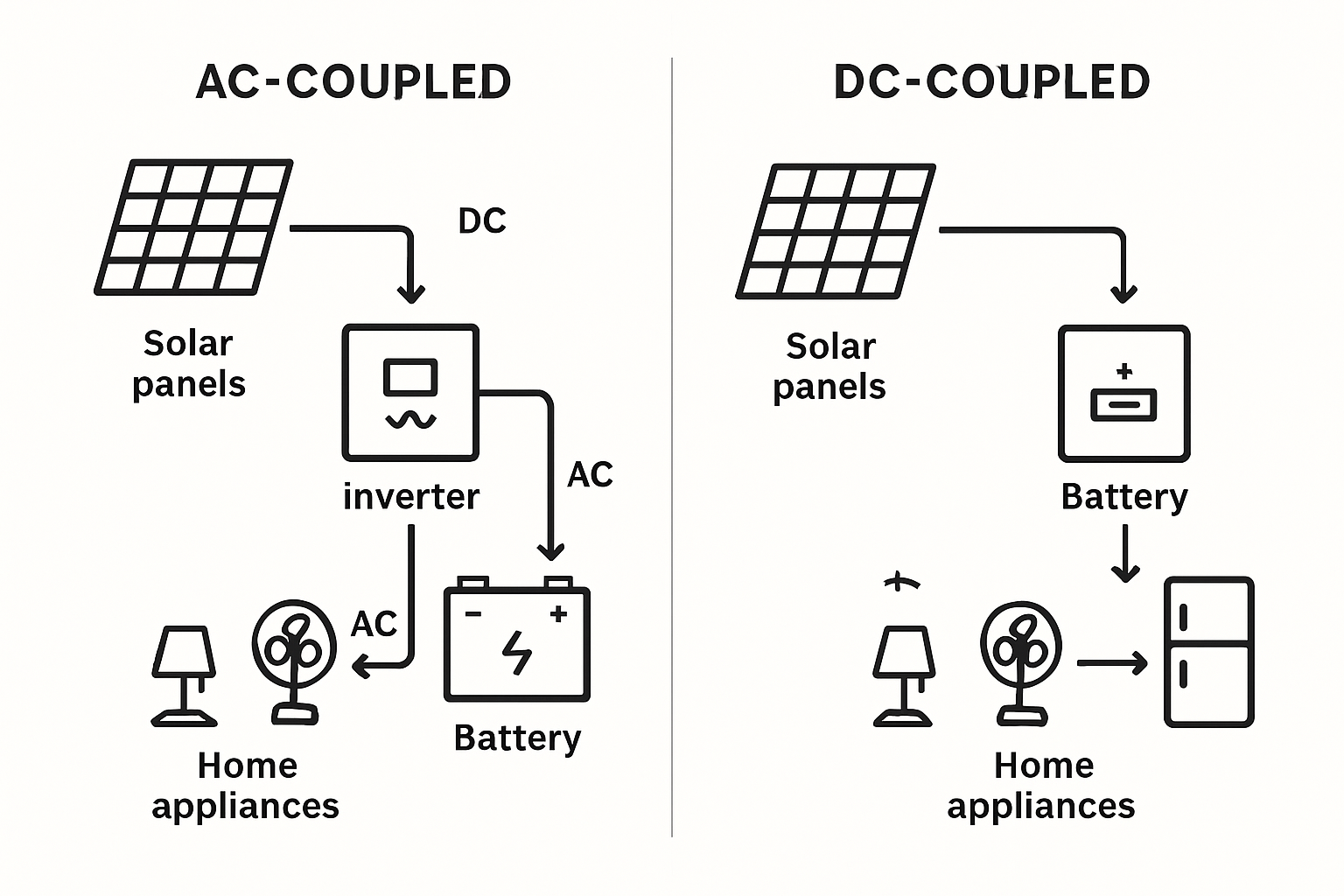Adding a lithium battery to a solar installation is a powerful step towards energy independence. As you consider your options, you will encounter two primary architectures: AC coupling and DC coupling. AC coupled storage, in particular, is surrounded by persistent myths regarding its efficiency, cost, and performance. This article separates fact from fiction, providing the clarity needed to make a well-informed decision for your energy needs.
Understanding the Fundamentals of AC Coupling
Before addressing the common misconceptions, it’s important to grasp how an AC coupled system works. This architecture is especially popular for adding energy storage to homes that already have a solar panel system installed.
What is AC Coupling?
Solar panels naturally produce Direct Current (DC) electricity. In a typical grid-tied solar system, a solar inverter converts this DC power into Alternating Current (AC) power, the standard form of electricity used in your home and on the grid. In an AC coupled system, a second inverter—an AC coupled battery inverter—is added with a lithium battery. This battery inverter takes surplus AC power, converts it back to DC to charge the battery, and then converts it back to AC when your home needs to draw power from the battery.
The Role of the Hybrid Inverter
Modern energy storage systems often use advanced inverters, sometimes called hybrid inverters, that can manage power flow from solar panels, the battery, and the grid simultaneously. In an AC coupled configuration, the 'hybrid inverter' acts as a smart battery inverter. It intelligently directs the flow of energy, deciding when to send solar power to your appliances, when to charge the battery with excess solar or cheap grid power, and when to discharge the battery to power your home.
AC vs. DC Coupling: A Quick Comparison
The choice between AC and DC coupling depends on your specific situation. DC coupling, where solar panels charge the battery more directly before any conversion to AC, is often used for new, simultaneous installations of solar and storage. AC coupling excels in retrofits.
| Feature | AC Coupling | DC Coupling |
|---|---|---|
| Best For | Adding batteries to existing solar systems | New solar and battery installations |
| Efficiency | Slightly lower due to more conversions (typically 90-94% round-trip) | Higher due to fewer conversions (up to 98% round-trip) |
| Installation | Simpler and less expensive for retrofits | More complex and costly for retrofits |
| Scalability | Highly flexible; battery system size is independent of the solar array | Battery size can be limited by the hybrid inverter's capacity |
Myth #1: AC Coupling is Inefficient Due to Multiple Conversions
One of the most common criticisms of AC coupling points to the multiple energy conversions required to store and retrieve battery power: from DC (solar) to AC (solar inverter), back to DC (battery inverter) for storage, and finally back to AC for use in the home.
The 'Efficiency Loss' Argument
The argument is that each conversion step results in a small energy loss, making the system inherently wasteful compared to a more direct DC-coupled architecture. While it is true that energy is lost during conversion, the real-world impact is often overstated.
Reality: High-Quality Inverters Minimize Losses
Modern, high-quality inverters are remarkably efficient, often achieving conversion efficiencies of 95% or higher. This means the total round-trip efficiency for an AC coupled system is typically in the 90-94% range. For many applications, this difference is marginal and does not significantly impact the system's overall financial return, especially when the energy being stored is surplus solar power that would otherwise be exported to the grid for minimal compensation.
Myth #2: AC Coupled Systems are Complex and Expensive to Install
The idea of adding a second inverter and more components can make AC coupling sound like a complicated and costly endeavor. However, this perception often overlooks the primary use case for this technology.
Reality: The Ideal Solution for Retrofitting
For a property with an existing grid-tied solar system, AC coupling is overwhelmingly the simplest and most cost-effective way to add lithium battery storage. The installation involves adding the battery and its dedicated inverter to the AC side of the system, requiring no changes to the existing solar panel wiring or the original solar inverter. This avoids the significant labor and expense of a complete system overhaul that a DC-coupled retrofit would require.
Cost-Benefit Analysis
While an AC coupled battery inverter is an added component, its cost is often less than the labor and equipment costs associated with redesigning an existing solar array for DC coupling. The modularity of AC coupling provides a straightforward upgrade path, making it a financially sound choice for millions of existing solar owners.
Myth #3: AC Coupled Storage Offers Limited Performance and Scalability
A final myth suggests that AC coupled systems are somehow less powerful or harder to expand than their DC-coupled counterparts. In reality, the opposite is often true, offering greater flexibility and independence between the solar generation and energy storage systems.
Reality: Independent and Flexible Scaling
Because the solar array and the battery system operate via separate inverters, they are functionally independent. This means you can size your AC coupled lithium battery bank based entirely on your storage needs, without being constrained by the size of your original solar inverter. If your energy needs grow, you can easily add more batteries without altering the solar generation side of your system. This modularity is a significant advantage for future-proofing your energy solution.
Performance Metrics That Matter
The core performance of an energy storage system is determined by the quality of its components, not just the coupling method. As detailed in the ultimate reference on solar storage performance, focusing on high-quality LiFePO4 (lithium iron phosphate) batteries ensures a high depth of discharge, long cycle life, and superior safety. These critical performance indicators are inherent to the battery technology itself. According to the International Renewable Energy Agency (IRENA), the shift towards lithium-ion chemistries like LFP is driven by their lower costs, longer lifespan, and better safety profile.
Making an Informed Decision for Your Energy Needs
Ultimately, the debate between AC and DC coupling isn't about which is universally 'better,' but which is right for your specific circumstances. AC coupled lithium battery storage is a proven, efficient, and highly flexible technology. It stands out as the premier choice for adding storage to an existing solar installation, debunking the myths of inefficiency and complexity. The global expansion of solar PV, which the International Energy Agency (IEA) projects will account for the vast majority of renewable growth, will only increase the demand for effective retrofit storage solutions like AC coupling.
By separating myth from reality, you can confidently assess your options. An AC coupled system provides a practical and scalable path to greater energy resilience and independence, allowing you to maximize the value of your solar investment.
Disclaimer: This article is for informational purposes only and does not constitute financial or investment advice. Consult with a qualified professional before making any decisions about your energy system.
Frequently Asked Questions
Can I add an AC coupled lithium battery to any existing solar system?
In most cases, yes. AC coupling is designed to be compatible with virtually any existing grid-tied solar system, regardless of the brand of the original solar inverter. It is one of the most versatile methods for retrofitting energy storage.
What is the typical round-trip efficiency of an AC coupled system?
The round-trip efficiency, which measures the energy you get out of the battery relative to the energy put in, is typically between 90% and 94% for modern AC coupled systems. While slightly lower than DC-coupled systems, the difference is often negligible in real-world performance and savings.
Is an AC coupled system suitable for off-grid applications?
Yes, AC coupled systems can be configured for off-grid use. A powerful AC coupled battery inverter can create a stable, independent microgrid, using the existing solar inverter as a power source to serve loads and charge the batteries. This provides a robust and flexible solution for achieving complete energy independence.





Leave a comment
All comments are moderated before being published.
This site is protected by hCaptcha and the hCaptcha Privacy Policy and Terms of Service apply.